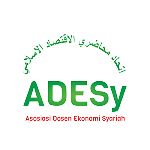Examining Maqasid Sharia Attainment: Case of Financing Products of Bank Muamalat Indonesia
DOI:
https://doi.org/10.18196/jiebr.v1i2.13Keywords:
Financing Products; Justice; Maqasid Sharia; Bank Muamalat; Islamic EconomyAbstract
The objective of the Islamic Bank is still profit-oriented while the Islamic economy, as the mother of the Islamic Bank, has the orientation to obtain the maqasid sharia that agreed as social well-being, which can not always be obtained by profit alone. The first pure sharia Islamic Bank in Indonesia is Bank Muamalat. As the first bank purely shariah, Bank Muamalat commit to promoting services that not only comply with sharia but are also competitive and accessible for entire citizen. Based on this background, this research aimed to evaluate financing products of Bank Muamalat by using the framework of maqasid limited to aspect of justice. This research was descriptive-qualitative using secondary data such as financial statements, types of Bank Muamalat financing products acquired from the Bank Muamalat site and brochure. Results of this research showed that financing products of Bank Muamalat could be considered as the attainment of maqasid sharia because those products are dominantly provided in the equity-based contract. But, the conditions determined for the equity-based contract in Bank Muamalat’s financing products make them considered as not promoting maqasid sharia.
References
Abozaid, A., & Dusuki, A. W. (2007). The Challenges of Realizing Maqasid Shariah in Islamic Banking and Finance. International Conference on Islamic Banking and Finance (pp. -). Kuala Lumpur: IIUM.
Abu Zahrah, Muhammad. (1958). Ushulu al-Fiqh. Damaskus: Dar al-Fikr al-‘Arabi.
Ahmed, H. (2011). Maqasid Shari'ah and Islamic Financial Products: a Framework for Assessment. ISRA International Journal of Islamic Finance , 149.
Al-Buti, M. Said Ramadhan. (2005). Dhawabit al-Mashlahah al-Shari’ah al-Islamiyah. Damaskus: Dar al-Fikr.
al Mubarak, T., & Osmani, N. M. (2010, - -). Applications of Maqasid al Shariah and Maslahah in Islamic Banking Practices: an Analysis. Retrieved May 15, 2021, from IIUM: http://irep.iium.edu.my
Al-Zuhayli, Wahbah. (1986). Ushulu al-Fiqhi al-Islami. Damaskus: Dar al-Fikr, Vol. 2.
Antonio, M. S. (2001). Bank Syariah: Dari Teori ke Praktik. Jakarta: Gema Insani Press.
Antonio, M., D., S., & Taufiq, M. (2012). An Analysis of Islamic Banking Performance: Maqasid Index Implementation in Indonesia and Jordania. Journal of Islamic Finance, Vol.1,No.1 , 012-029.
As-Shatibi, Ibrahim Ibn Musa Ibn Muhammad. (2006). Al-Muwafaqat. Kairo: Dar Ibn ‘Affan, Volume 2, Edition 2.
Auda, J. (2007). Fiqh al-Maqasid: Inathah al-Ahkam al-Shar'iyyah bi Maqasidiha. USA: International Institute of Islamic Thought.
Auda, J. (2008). Maqasid al-Shari'ah: a Beginner's Guide. Occasional Paper Series 14 , -.
Bakri, A. J. (1996). Konsep Maqasid al-Syariah Menurut al-Syatibi. Jakarta: RajaGrafindo Persada.
Bedoui, H., & Mansour, W. (2013). Islamic Bank Performance and Maqasid Shariah. 9th Asia-Pacific Economic Association Conference (pp. -). Osaka: -.
Dusuki, A. W., & Bouheraoua, S. (2011). The Framework of Maqasid Sharia (Objectives of the Sharia) and Its Implications for Islamic Finance. ISRA Research Paper, No.22 , -.
Hancock, Beverley, Elizabeth Ockleford and Kate Windridge. (2009). An Introduction to Qualitative Research. Nottingham: NIHR RDS.
Hosen, M. N., & Nahrawi, A. A. (2012). Comparative Analysis of Islamic Banking Products between Malaysia and Indonesia. International Journal of Academic Research in Economics and Management Sciences, Vol.1, No.2 , -.
Indonesia, R. M. (2012). Pembangunan Ekonomi Umat: Tafsir al-Qur'an Tematik. Jakarta: Direktorat Urusan Agama Islam dan Pembinaan Syariah.
Jalil, A. (2006). The Significances of Maslahah Concept and Doctrine of Maqasid (Objectives) al-Shariah in Project Evaluation. The Journal of Muamalat and Islamic Finance Research (JMIFR), Vol.3, No.1 , 171-202.
Karim, A. (2013). Bank Islam: Analisis Fikih dan Keuangan. Jakarta: RajaGrafindo Persada.
Meryana, E. (2013, September 18). Bank Muamalat Kembali Jadi Bank Syariah Terbaik di Indonesia. Retrieved May 14, 2021, from swa: http://www.swa.co.id
Mohammad, M. O., & Shahwan, S. (2013). The Objectives of Islamic Economic and Islamic Banking in Light of Maqasid Shari'ah: a Critical Review. Middle-East Journal of Scientific Research , 75-84.
Mohammad, M. O., Razak, D. A., & Taib, F. M. (n.y., - -). The Performance Measures of Islamic Banking Based on the Maqasid Framework. Retrieved April 05, 2020, from IREP IIUM: http://www.irep.iium.edu
Muamalat, B. (2016, - -). Annual Report. Retrieved May 14, 2021, from Bank Muamalat: http://www.muamalatbank.com
Muamalat, B. (2018, - -). Annual Report. Retrieved May 14, 2021, from Bank Muamalat: http://www.muamalatbank.com
Muamalat, B. (2020, - -). Annual Report. Retrieved May 14, 2021, from Bank Muamalat: http://www.muamalatbank.com
Muhammad. (2005). Manajemen Pembiayaan Bank Syariah. Yogyakarta: UPP AMP YKPN.
OJK. (2020, Desember -). Statistik Perbankan Syariah. Retrieved May 15, 2021, from OJK: http://www.ojk.go.id
Rawls, J. (2005). A Theory of Justice. Cambridge: Harvard University Press.
Rosly, S. A. (2010). Shariah Parameters Reconsidered. International Journal of Islamic and Middle Eastern Finance and Management, Vol.3, No.2 , -.
Shaharuddin, A. (2010). Maslahah-Mafsadah Approach in Assessing the Shariah Compliance of Islamic Banking Products. International Journal of Business and Social Sciences, Vol.1, No.1 , -.
Suharso, Y. (2014, February 24). Bank Muamalat Indonesia, Bank Syariah Terbaik Enam Kali. Retrieved May 14, 2021, from mysharing: http://www.mysharing.com
Yusof, E. F., Ogie, J. K., & Kamal, A. A. (February 2010). Islamic Finance: Debt versus Equity Financing in the Light of Maqasid Shariah. MPRA Paper, No.20722 , -.
Downloads
Published
How to Cite
Issue
Section
License
Copyright (c) 2021 Journal of Islamic Economic and Business Research

This work is licensed under a Creative Commons Attribution-NonCommercial 4.0 International License.
Journal of Islamic Economic and Business Research has CC-BY NC or an equivalent license as the optimal license for the publication, distribution, use, and reuse of scholarly work for non-commercial purpose. The non-commercial use of the article will be governed by the Creative Commons Attribution license as currently displayed on Creative Commons Attribution-NonCommercial 4.0 International License
Creative Commons License




